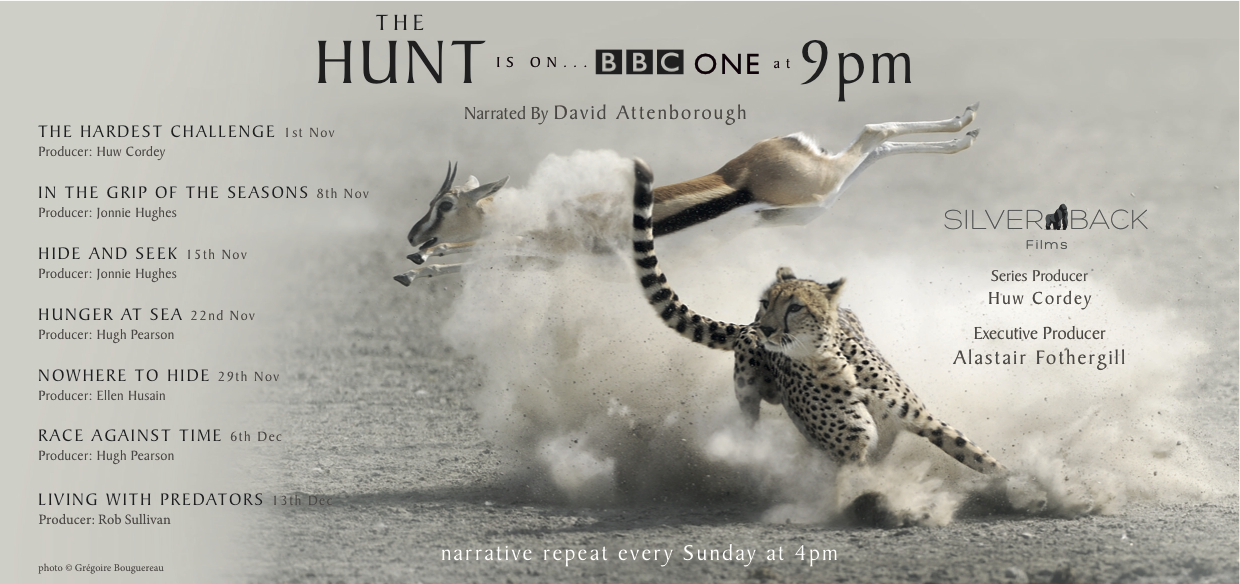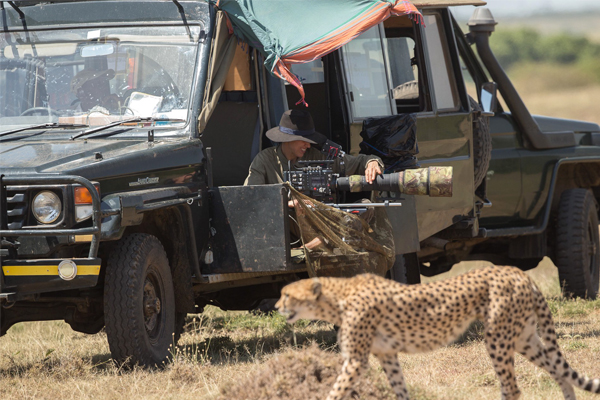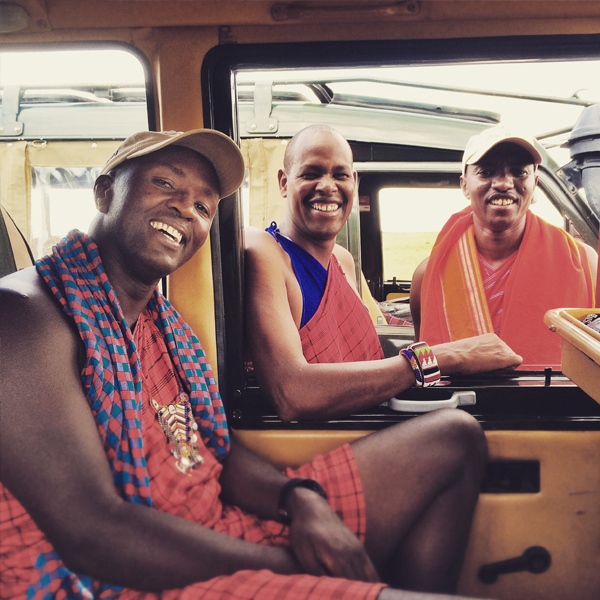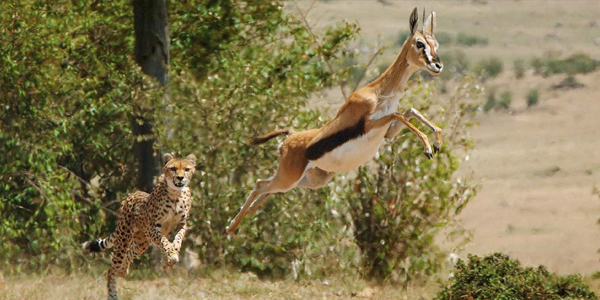The Hunt is on… Behind the Scenes of BBC One’s new series
On the 1st of November a major new wildlife series ‘The Hunt’ starts on BBC One, narrated by David Attenborough. I have to stop myself here as the line ‘narrated by David Attenborough’ is pretty much the zenith of any wildlife filmmaking career. His series ‘Life on Earth’ inspired and instilled a love of natural history so strong that I am now a wildlife camerawoman. Over the past few years I’ve been fortunate enough to be a part of the Core Crew filming stories for ‘The Hunt’ all over the world. From Bears in Alaska, Orca in Patagonia, Monkeys in Thailand to Namibian lions & Ethiopia’s wolves. And last February to Kenya’s Masai Mara, a place I know well, to film cheetah.
The Hunt explores the complex relationships between predator and prey, the challenges faced by both hunter and hunted. As many Asilia safari goers know a hunt rarely ends with a kill. In the case of the cheetah, despite being one of Africa’s most successful predators, it’s a roughly 50% chance of success – very much an equal match.
Our crew arrived into the Mara in February 2015 for five weeks. Our brief from the show’s Director Alastair Fothergill was to “visually unpick every little detail of the contest between the predator and its prey.” Jamie McPherson was filming with a specialist Cineflex rig – a gyroscopic long lens camera system he’s developed that allows you to track alongside an animal. I was on the super slo motion Phantom 4K Flex, both cameras are state of the art systems which would hopefully give us the extra edge & revelationary feel that we were after. Cheetah hunts have been shown many times and it was important that we learnt something new from this sequence. Asilia’s Gerard Beaton had set up one of their Nomadic camp’s close to where a cheetah, Malaika and her four cubs, were being regularly being seen. We’d heard great reports about Malaika and pinned our hopes on her becoming our star.
The last time I’d filmed cheetah was also in The Mara from 2008-2010 when I’d the privilege of following ‘Sita’ & her cubs for a Disney Nature feature film ‘African Cats’. I never thought
I would see her equivalent again but Malika, like Sita was an exceptional hunter. There’s something quite extraordinary about spending a prolonged period filming one animal. You really begin to understand their traits and habits, every cheetah is different. One of the reasons we’d chosen to follow Malaika was her four eight month old cubs who were getting bigger every week. This meant she was having to hunt almost daily and ensured a better chance of getting some good attempts, possibly even with larger prey. And this turned out to be the case, the Loita wildebeestes herds had started to drift into the park with their calves and Malaika had a field day.
A cheetah can explode from static to 30m in a single second – breathtakingly fast. It requires years of experience and field craft to be in the best possible place for a hunt without compromising any of the action. It’s very important to us to record natural behaviour and not to influence a hunt in any way and this meant having the best team of drivers and spotters on board. A combination of the Asilia guides and specialist film driver Sammy Munene – all experienced naturalists – were going to give us the best chance we had of getting those shots. It goes without saying though that wildlife filming rarely goes exactly to plan…you can only shoot what you have in front of you. The opening shot of the series illustrates this aptly, a Thompson’s gazelle stotting in ultra slow motion through frame, as if possessed, closely followed by Malaika. We were delighted with the shot but it’s not what I’d set out to film, Malaika coming straight down the barrel of the lens. As Malaika had started stalking I’d framed up on her but she disappeared into thick croton bushes and I’d no option but to reframe on one of the nearby female Tommys – her most likely prey. As Malaika broke cover the Tommy began to stot, and I started to film. It was an incredible jump showing her beauty and peak fitness. When you see the shot you might think the Tommy is jumping for joy however as Malaika enters the frame you understand the Tommy’s plight, this is a leap for life. Both animals thunder out of frame, the shot showed the challenges perfectly – these two, like so many predators and prey were an equal match.
Over the month we followed Malaika, our luck was in and the cheetah family stayed within a few miles of camp for the duration of our stay. Our cheetah footage is in the opening episode and ‘Nowhere to hide’ programmes of the series, both Malaika’s successes and failures. On every shoot I keep notes and it looks like Malaika beat the statistics – and then some – over the course of our month with her. My notes record that she made just fifteen attempts and twenty kills from Thompson gazelle fawns to wildebeests calves, losing only one kill to hyena – quite incredible. On two mornings we found her fat as an egg and could only presume she’d hunted at night, which female cheetahs aren’t really supposed to do… there’s still an awful lot we don’t know about these stunning and extraordinary animals. Hopefully on ‘The Hunt’ we have shown this predator prey relationship in a fresh way but we certainly have so much still to learn. Which is great, because it means that one day I may get to film cheetah again!
About the Author
Sophie Darlington has been making blue chip wildlife feature films and television throughout the world for over 20 years and was mentored by filmmaker Hugo van Lawick under huge Serengeti skies in Tanzania.
www.sophiedarlington.com, Twitter @S_Darlington
Read more about the making of The Hunt
Socks, chocolate and saddle sores: Filming The Hunt
Predator vs Prey: How ‘The Hunt’ was filmed
The post The Hunt is on… Behind the Scenes of BBC One’s new series appeared first on Asilia Africa.
More Wildlife & Conservation Articles

Leopard vs Cheetah : Can You Tell The Difference
01 April 2020How often do you mistake a leopard for a cheetah or vice versa? I’m sure we’v...

What’s the difference? National Parks, Game Reserves, and Conservancies in East Africa
02 February 2020To most of us, a national park, game reserve, or conservancy are all the same...

Electric Vehicles: The Future Of East African Safari Travel?
12 January 2020October 2019 saw the arrival of our first electric, solar-powered safari vehi...

Guest Gallery: The Serengeti At Its Best
27 November 2019We recently had the pleasure of welcoming guests, Chris and Monique Fallows t...









